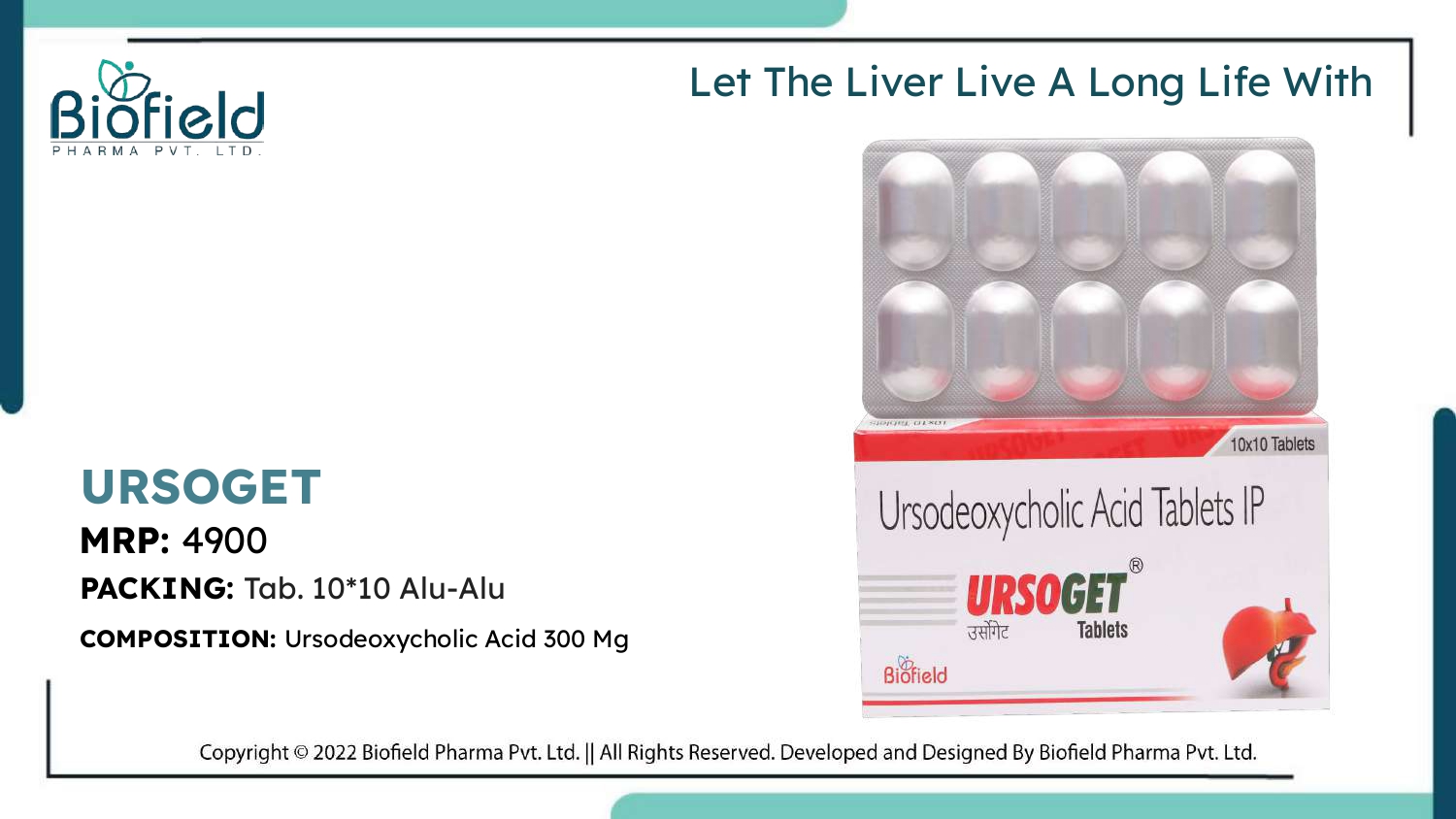- Home
- GENERAL RANGE
- URSOGET
URSOGET
₹4,900.00
Ursodeoxycholic Acid 300 Mg
SKU: 90bc27212ee0
Categories: GENERAL RANGE, TABLET, TABLET & CAPSULES
Ursodeoxycholic Acid 300 mg Tablet
Biofield Pharma Pvt Ltd has launched their product under the brand name ‘URSOGET’. This product contains Ursodeoxycholic Acid 300 mg in the form of a tablet that is packaged in ALU-ALU packaging with a size of 10 x 10. This tablet is being prescribed by General Physicians. URSOGET: Ursodeoxycholic Acid 300 mg TABLET ensures your liver a long & healthy life. As a result, impaired biliary secretion is stimulated. This medication is highly effective in preventing gallstone formation. It reduces serum fibrosis makers in NASH and reduces the passage of bile acids to the fetus in ICP. In nonalcoholic fatty liver disease, nonalcoholic steatohepatitis (NASH) is progressive. NAFLD is caused by the accumulation of fat in the liver. When this buildup causes inflammation and damage, it is known as NASH. The most common liver disease during pregnancy is cholestasis of pregnancy (also called gestational cholestasis or gestational cholestasis)..HOW DOES IT WORK?
The ingredient in URSOGET is Ursodeoxycholic acid, which is a natural bile acid. URSODEOXYCHOLIC ACID works to reduce the formation of cholesterol in the blood, so it dissolves gallstones. URSODEOXYCHOLIC ACID protects liver cells from damage caused by toxic bile acids and improves liver function. Ursodeoxycholic acid is a hepatoprotective drug. It works by lowering blood cholesterol and helping to dissolve gallstones whose main component is cholesterol. It also improves liver enzymes, protects liver cells from damage caused by toxic bile acids, and improves liver function.BENEFITS
- Biliary sludge
- Gallstone dissolution
- Cholestatic liver disease
- Alcoholic liver disease
- Non-alcoholic steatohepatitis
- Intrahepatic Cholestasis of pregnancy
INDICATIONS
URSOGET: Ursodeoxycholic Acid 300 mg TABLET is indicated for the treatment of primary biliary cirrhosis and the dissolution of small and medium-sized radioactive cholesterol-rich gallstones in patients with an active gallbladder. URSODEOXYCHOLIC ACID belongs to a group of drugs called biliary drugs or gallstones that are used to treat gallstones, primary cholangitis (an autoimmune disease of the liver), excess cholesterol in the bile, and children over 6 years with liver and biliary diseases due to cystic fibrosis.ADMINISTRATION OF DOSE
Dosage for primary biliary cirrhosis in adults, 10 to 15 mg of Ursodeoxycholic acid per kg per day in two to four divided doses is recommended. For children: the dose can be adjusted according to body weight. The dosage and duration of treatment depend on the patient's medical history as well as age and sex. The dosage also depends on the route of administration and the primary problem for which the medicine is prescribed. The dose to dissolve gallstones in adults is 6 to 12 mg/kg/day, as a single dose nightly or in divided doses. The dose may be increased to 15 mg/kg/day in obese patients, if necessary. For children, the dosage should be adjusted based on their weight. For children with cystic fibrosis from 6 years to less than 18 years: 20 mg/kg/day in 2-3 divided doses may increase further to 30 mg/kg/day if needed.SIDE EFFECTS
You can get mild to moderate side effects when using the drug. As soon as the period of treatment is over, such adverse effects fade away. However, speak with your doctor immediately if you are concerned about the side effects. Such symptoms may include abdominal discomfort, abdominal pain, diarrhea, nausea, rash, dizziness, indigestion, and weakness.PRECAUTIONS
Ursodeoxycholic acid in the form of a tablet must be taken under the supervision of a doctor or qualified nurse. During the first 3 months of treatment, liver function parameters AST (SGOT), ALT (SGPT) and should be monitored by the physician every week, then every 3 months. In addition to allowing for the identification of responders and non-responders in patients treated for primary biliary cirrhosis, this monitoring will also allow early detection of liver deterioration, particularly in patients with cirrhosis, and severe primary hepatobiliary disease. When used to dissolve cholesterol gallstones: To assess treatment progress and detect any calcifications of gallstones early, depending on the size of the gallstones, visualization of the gallbladder (photography) is recommended. oral gallbladder) with generalized and occlusal images in the standing and supine positions (ultrasound control) 6 to 10 months after initiation of treatment. If the gallbladder cannot be seen on radiographs, or if calcified gallstones are present, gallbladder contractility is impaired, or biliary colic episodes are frequent, Ursodeoxycholic acid should not be used. When used to treat severe primary biliary cirrhosis:- In very rare cases, decompensated cirrhosis has been observed, which partially regressed after treatment was discontinued.
- In case of diarrhea, the dose should be reduced and in the case of persistent diarrhea, treatment should be discontinued.
- Patients with rare hereditary problems of galactose intolerance, Lapp lactase deficiency, or glucose-galactose malabsorption should not take this medicine.
- Take the missed dose of the medicine immediately. If your next dose is approaching, skip the missing one and resume your regular regimen. Don't increase the dosage.
Related products
-
AFTERCOLD N
₹750.00 -
IFCOF
₹95.00 -
EBAGRIP -10
₹600.00 -
IFCOF-XT
₹139.00
Enquire Us

×







